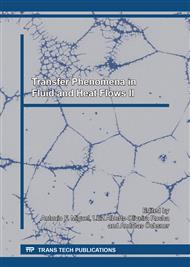[1]
Fluent, Fluent 6. 3 User's Guide, Fluent Inc, USA, (2006).
Google Scholar
[2]
H. Schäffer, G. Klopman, Review of multidirectional active wave absorption methods, J. Waterw. Port. Coast. Ocean Eng. 126 (2000) 88-97.
DOI: 10.1061/(asce)0733-950x(2000)126:2(88)
Google Scholar
[3]
J.L. Lara , A. Ruju, I.J. Losada, Reynolds averaged Navier-Stokes modelling of long waves induced by transient wave group on a beach, In Proceedings of R. Soc. A. 467 (2011) 1215-1242.
DOI: 10.1098/rspa.2010.0331
Google Scholar
[4]
P. Higuera, J.L. Lara, I.J. Losada, Realistic wave generation and active wave absorption for Navier-Stokes models applications to OpenFoam®, Coastal Engineering 71 (2013) 102-118.
DOI: 10.1016/j.coastaleng.2012.07.002
Google Scholar
[5]
E. Didier, M.G. Neves, A Semi-Infinite Numerical Wave Flume using Smoothed Particle Hydrodynamics, IJOPE 22(3) (2012) 193-199.
Google Scholar
[6]
A. Torres-Freyermuth, J.L. Lara, I.J. Losada, Numerical modelling of short- and long-wave transformation on a barred beach, Coastal Engineering, 57 (2010) 317-330.
DOI: 10.1016/j.coastaleng.2009.10.013
Google Scholar
[7]
C.W. Hirt, B.D. Nichols, Volume of fluid (VoF) method for the dynamics of free boundaries, J. Comp. Phys. 39 (1981) 201-225.
DOI: 10.1016/0021-9991(81)90145-5
Google Scholar
[8]
M. Peric, J.H. Ferziger, Computational Methods for Fluid Dynamics, 2nd ed. Berlin, Springer, (1997).
Google Scholar
[9]
J.M. Paixão Conde, P.R.F. Teixeira, E. Didier, Numerical simulation of an oscillating water column wave energy converter: Comparison of two numerical codes, In Proceedings of 21th International Offshore and Polar Engineering Conference (2011).
Google Scholar
[10]
E. Didier, J.M. Paixão Conde, P.R.F. Teixeira, Numerical simulation of an oscillation water column wave energy converter with and without damping, In Proceedings of 4th International Conference on Computational Methods in Marine Engineering, Lisbon (2011 ) 206-217.
Google Scholar
[11]
P.R.F. Teixeira, D.P. Davyt, E. Didier, R. Ramalhais, Numerical simulation of an oscillating water column device using a code based Navier-Stokes equations, Energy 61 (2013) 513-530.
DOI: 10.1016/j.energy.2013.08.062
Google Scholar
[12]
R.G. Dean, R.A. Dalrymple, Water wave mechanics for engineers and scientists, World Scientific, Singapore, (1991).
Google Scholar


